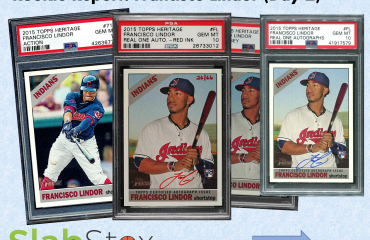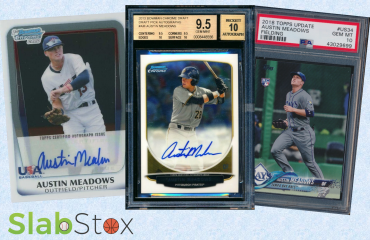Taking a Stab at Vintage: Ty Cobb Green Portrait

As I arrived at the 2014 National Sports Collectors Convention in Cleveland, I was overwhelmed with excitement. It was my first show and I was there extra early, waiting in line for the gates to open on Preview Day.
At the time, I strictly collected football cards. I had my Eddie Lacy 2013 Topps Chrome Gold Refractor Rookie Autograph /10 in my hand. As soon as those gates opened, I headed straight to Beckett’s booth to get on-site, same-day grading. If memory serves me correctly, it was $30 to get it back the next morning. (Crazy cheap compared to today!)
After I dropped it off, I turned around and saw a sea of old cards. At the time, I did not know anything about vintage cards. I knew rookies of old players went for decent coin, but I had no understanding of grading, condition, rarity, anything like that. As I walked around I had no interest in them. I probably was thinking, “These aren’t shinny, so they can’t be worth a lot.” Fast forward four and a half years, and now I am doing research on these “old cards.”
Recently, someone suggested I start doing research and insights on popular vintage cards to expand my audience by providing graphs and trends on recent sales. Since I had to start somewhere, I asked a vintage Facebook group what cards they would like me to run insights on. A couple members requested the 1909-1911 T206 Ty Cobb Green Portrait in various PSA grades, specifically 1, 2, and 3.
I had no expectations going into this since it’s the first time I have ever researched historical data of vintage cards. The most I have ever done is checked out some low-grade Hank Aaron rookies because some day I would like to add one to my collection.
A few notes:
- These graphs show the sale history (both auction and fixed) from the past 5 years.
- Since my knowledge for vintage is low, there is a chance that one or two of these sales are of a different back, as I cannot see pictures of what sold before March 2018.
- Some collectors suggested only including Piedmont and Sweet Caporal backs in my data. I tried my best.
- I deleted out sales that were much higher than the others from the relevant time frame as those are outliers, and most likely Sovereign backs.
a
A few things I learned:
- Ty Cobb Green Portraits are rare. Like really rare. So rare that over the past 5 years, only 86 total copies of Cobb Green Portraits (with the relevant backs) in PSA 1, 2, or 3 have sold.
- When it comes to low grade vintage cards, the card’s condition (ignoring grade) matters a lot. That makes sense, of course. But when you normally invest in modern 9s, 9.5s, or 10s, it really is mind blowing.
- Because of this, I listed a range of percent increases over the period (from first sale to last sale), since condition and price relation is sensitive when it comes to the same grade of a card.
- I am surprised that the PSA 1 copies have increased at a faster rate than the other grades. However, it makes sense if you look at it as people want to invest for a lower cost, so the overall market likely would increase faster.
PSA 1
By the numbers
Amount sold in 5 years: 45
Total $ in sales: $57,982.94
Average per card: $1,288.51
*Note: Each percentage below is in regards to the year prior (ex. 2017 average was 52.37% higher than 2016 average).
2014 Average: $779.75 – 4 sold
2015 Average: $705.69 – (-9.50%) – 10 sold
2016 Average: $894.83 – (+26.80%) – 12 sold
2017 Average: $1,363.45 – (+52.37%) – 8 sold
2018 Average: $2,520.10 – (+84.83%) – 9 sold
2019 Average: $1,740.30 – (-30.94%) – 2 Sold
Average % Change (2014 to 2018): +223.19%
I excluded 2019 in the average percent increase since there has only been two sales in 2019, one of which is the lowest since March of 2017.Each year, the PSA 1 has rose by a significant amount. So far in 2019, there has not been enough sales to justify the -30.94% dip. I would except it to stay on its upward trend going into the future, based off of past performance.
To show what I mentioned earlier about the variation in condition, check out what the $1,180.60 sale looked like (the last to be recorded).
PSA 2
By the numbers
Amount sold in 5 years: 25
Total $ in sales: $61,412.56
Average per card: $2,456.50
2014 Average: $1,396.73 – 5 sold
2015 Average: $1,618.00 – (+15.84%) – 4 sold
2016 Average: $2,172.00 – (+34.24%) – 7 sold
2017 Average: $3,296.66 – (+51.78%) – 3 sold
2018 Average: $3,911.40 – (+18.65%) – 5 sold
2019 Average: $3,305.90 – (-15.48%) – 1 sold
Average % Change (2014 to 2018): +180.04%
Once again, I went with the 2018 five sale average for the average % gain.The PSA 2 was seeing substantial growth as well, but in 2018 it saw its lowest gain since 2015. I will be curious to see if it gets back over the +50% hump in 2019.
PSA 3
By the numbers
Amount sold in 5 years: 16
Total $ in sales: $64,592.45
Average per card: $4,037.03
2014 Average: $2,363.20 – 5 sold
2015 Average: $2,420 – (+2.40%) – 1 sold
2016 Average: $3,542.78 – (+46.40%) – 3 sold
2017 Average: $5,058.67 – (+42.79%) – 3 sold
2018 Average: $6,138.02 – (+18.65%) – 4 sold
Average % Change (2014 to 2018): +159.73%
Performing slightly worse over the five year average, the PSA 3 is still a strong investment. It has netted the largest dollar gain over the period.
If this vintage card was a Bowman Chrome auto, I would think, “Why would you not invest in multiple PSA 1s? It is netting the largest percent gains.” But when considering that there have been only 86 copies of all PSA 1, 2, and 3 over the past five years, it is almost impossible to do that and be effective.
While I knew nothing about the vintage market coming into this blog, I sure learned a lot about how the market moves (at least on this T206 Cobb) and the type of steady positive gains that can be realized from investing in vintage.
I must admit, whenever I hear people say “alternative assets” when referring to cards, vintage always comes to my mind. These graphs proved to me why.
Sign up for The Daily Slab email to get the most up-to-date sports card insights straight to your inbox.



